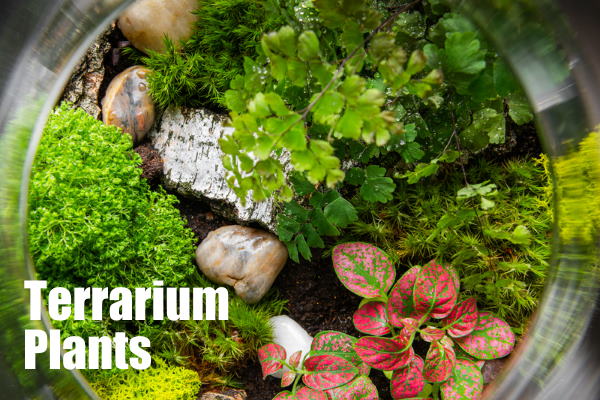Terrarium Plants
Ideal terrarium plants are native to tropical habitats. Because of their love for high humidity, they are well-suited for the humid environment of a terrarium.
Are there tropical plants you've always wanted to grow, but didn't dare try because you live in a dry climate? Well, here's your opportunity to grow those elusive, exotic plants -- in the perfect eco system that you create.
Terrariums are easy to make. Get step-by-step instructions on how to make a terrarium.
 Small ferns, tropical plants and mosses make ideal terrarium plants. Photo © Marcin Jucha
Small ferns, tropical plants and mosses make ideal terrarium plants. Photo © Marcin JuchaWhat Type of Plants to Grow
Many tropicals will thrive in humid conditions. Look for small or slow-growing plants that won't take over the terrarium. Those with dense foliage are especially attractive.
Here are a few of my favorites:
- Maidenhair Fern
- Polka Dot Plant
- Peperomia Caperata
- Nerve Plant
- Venus Fly Trap
- Clubmoss
Terrarium Plants for Sale
Choose a variety of plants that vary in growth habit, height, and texture for an interesting landscape.
Another thing to consider is the type of light each one needs. Don't combine a plant that likes bright light with several that prefer mostly shade. If they're not compatible, some will suffer.
It's a good idea to avoid flowering plants. Why? Many of them have different light requirements throughout the year. Also, dead flowers may be difficult to remove and will rot. Need another reason? Most flowers require good air circulation to prevent powdery mildew and fungus. Enough said.
Tips for Preparing Plants
Pinch off growing tips and prune tall or spreading plants to keep them from getting too big.
Also, prune any yellow or dead leaves because they will attract mold in the humid environment of a terrarium. It's easier to groom them now than after they're planted.
Before placing any plant to your terrarium, look it over carefully for insects, fungus, mildew or root rot. You don't want to add these problems to your miniature eco system, because they are especially contagious under glass.
How to Care for Terrarium Plants
Good news! Once your terrarium is planted, the after-care part is easy. Your plants will thrive nestled in their virtually self-sustaining environment, away from drafts and dry air. Here are a few helpful tips to keep terrarium plants healthy:
Water sparingly. After planting, mist your plants or trickle water onto the potting mix to moisten it. Once established, you'll only need to water them once every month or two. Watch your plants. If they're beginning to wilt, add a little water. Always water lightly. Too much water is difficult to get rid of because it evaporates slowly in an enclosed container.
Green Thumb Tip
Because they maintain humidity, terrariums don't need watered as often as other houseplants.
Water only when the top of the soil is dry, and always water lightly. Too much water will result in soggy soil -- or worse -- standing water, creating an ideal environment for fungi, diseases and root rot.
Don't let it get steamy. Condensation on the inside of the glass can be a problem, especially immediately after planting and watering for the first time. If the glass mists over and will not clear, leave the terrarium open for a few hours to allow excess moisture to escape. After the garden has settled down, it shouldn't be necessary to ventilate it again.
Give it light. Put your terrarium where it will get plenty of bright light, but out of direct sun. Direct sunlight shining through the glass for as little as an hour or two will cook the plants. Don't have a bright location for your terrarium? Artificial lighting works wonderfully, too.
Pinch and Prune. Remove dying leaves as soon as you notice them. They'll likely rot and attract fungus. You'll help some plants branch out by pinching off growing tips, creating bushier, more attractive plants. Pinching also helps control their height so plants don't outgrow their containers.
More to Explore - Cases, Kits and Supplies
One of the earliest terrariums was the Wardian Case, a glass box created by Dr. Nathaniel Ward in 1829. It was used by plant collectors to protect plants from salty air and other unfavorable conditions as they were shipped by sea.
Victorian gardeners soon transformed the idea into the decorative terrariums we use today to house humidity-loving tropical plants.
Glass bell jars -- those old-fashioned domes used to protect garden plants from frost -- have come indoors. More popular than ever, the Glass Cloche is a beautiful way to maintain humidity for a single tropical plant.
Short on space? You can squeeze houseplants in practically anywhere. Add a modern dimension to a room with a hanging terrarium. Mini terrarium kits are easy to put together and care is a breeze.
Short on time? Putting together a small terrarium has never been easier. Check out these terrarium kits that go together in minutes.
Grab your supplies and make a unique garden-in-a-jar. Get your terrarium supplies, such as tools, moss and pebbles, plus ornate globes and jars.


